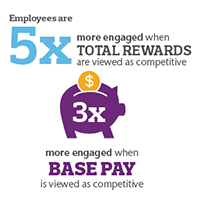How to ensure a relevant and sustainable insured employee benefits program
There is a generally accepted belief that if organisations pay employees enough, they will be more productive and engaged.

Recent research by Aon Hewitt
1 indicates there is a strong correlation between employee perceptions of their benefits or rewards and their overall engagement levels. Employees who value their total rewards package, including benefits, are five times more engaged in their workplace compared to only three times if their base pay only is seen as competitive. Therefore, organisations who take the time to develop and maintain a benefits program are most likely to see the advantages of increased employee engagement.
Investing in a relevant and sustainable insured employee benefits program, which typically includes health insurance, salary continuance, life and total disability insurance, should form part of an organisation’s strategy to attract and retain the best talent, and to ensure the ongoing success of your business. Failure to attract and retain the best talent is one of the top 10 risks facing Australian business today, according to Aon’s 2017 Global Risk Management Survey.
Research and experience tells us that investing in an employee benefits program makes good business sense but if the cost of the program is unsustainable or if employees do not feel it is relevant to them, then the impact of the program will be significantly reduced.
Aon has developed a series of questions that all organisations should ask themselves to understand if their program is relevant and sustainable. Neil Robinson, Sales Director, Aon picks out three of these questions and explains why they are so important:
- Are the benefits understood by employees?
Effective communication of benefits must be at the cornerstone of your benefits strategy. For many organisations, this can be challenging due to the sheer volume of communications employees receive on a daily basis, along with other barriers such as remote working.
Whilst each organisation is different, we believe best practice in communicating your benefits program is two-fold. Firstly, create a place where all information on your benefits is stored. This can be on the company intranet, on a dedicated benefits portal or even on a notice board in the kitchen. The key is for employees to know where to go when they want to find information. Secondly, consider how you can deliver information to your employees when it is most relevant to them. If you can match employee communication of benefits with employee life stages, the relevance of the program to your employees will increase. For example if you know an employee is having a baby, provide them with information about their health insurance and what they can do to get the most from this cover.
- Are you prepared for future cost increases?
Group insurance and health insurance premiums have generally been increasing over recent years. Failing to understand these market conditions and navigate through the price increases can affect the sustainability of your program.
As a minimum, we recommend organisations keep regularly updated of market conditions in a timely manner, allowing for effective budgeting for further investments in benefits programs.
At Aon, we see best practice as taking a proactive approach to people risk management strategies to reduce or minimise insurance claims. By understanding your key people risks and implementing a targeted wellness program to address these will maximise the opportunity for sustainable insurance programs. The impact of the approach can further be enhanced by partnering with Aon who can articulate your people risk approach to the insurance market to attract the most competitive premiums.
- Do you know what benefits your employees actually value?
When did you last ask your employees about what benefits they actually value?
Seeking feedback from employees and engaging them in the design and ongoing review of the program can increase the relevancy. This should be done via robust surveys which use trade off questions. For example, would they value an increase in health insurance funding over an additional contribution to superannuation? Organisations should not simply ask what employees want in the form of a shopping list. We see best practice in this area involving the use of small focus groups which allow organisations to gather more qualitative data and insights from employees.
If you want to understand whether your employee benefits program is sustainable and relevant, contact Aon today. We can guide you through the series of questions and assist you in driving your business to success with employee benefits.
1 ;Aon Hewitt Workforce Mindset Study>;